China’s decision to pause its gold-buying spree, particularly by its central bank, the People’s Bank of China (PBOC), reflects a significant development in the global gold market dynamics. For over 18 months, China had been on a relentless streak of accumulating gold reserves, making it the world’s largest institutional buyer of the precious metal. However, this streak came to a halt in May, with official data indicating that China’s gold reserves remained unchanged from the previous month.
The decision to halt gold purchases comes at a time when gold prices have soared to record highs, reaching nearly $2,450 per ounce in May before experiencing a slight pullback. This surge in gold prices, driven by various factors including geopolitical tensions and economic uncertainties, has made gold acquisition increasingly expensive, prompting even major players like the PBOC to reassess their strategies.
Ewa Manthey, a commodities strategist at ING Bank, highlighted the vulnerability of gold prices to further downward pressure in light of China’s decision to halt its gold purchases. The pause in acquisitions by the PBOC has left the gold market susceptible to fluctuations, with investors closely monitoring developments for cues on future price movements.
China’s central bank had already begun to scale back its gold purchases in April, acquiring only 60,000 troy ounces compared to significantly higher volumes in preceding months. This gradual slowdown culminated in a complete pause in gold acquisitions in May, signaling a shift in China’s approach to gold accumulation.
Despite the pause in gold purchases, China’s appetite for gold remains significant, driven by factors such as economic uncertainties and a weak Chinese yuan. Gold has long been viewed as a safe-haven asset, particularly during times of geopolitical turmoil and market volatility, making it an attractive investment option for individuals and institutions alike.
David Tait, CEO of the World Gold Council, suggested that China’s decision to pause gold purchases may be temporary, with the central bank closely monitoring market conditions. Tait indicated that a potential correction in gold prices to around $2,200 per ounce could prompt China to resume its gold-buying activities, underscoring the dynamic nature of the gold market.
Overall, China’s decision to halt gold purchases reflects the complex interplay of economic, geopolitical, and market factors shaping global gold demand and prices. As investors and central banks navigate uncertain waters, the outlook for gold remains subject to ongoing developments and shifts in market sentiment.
